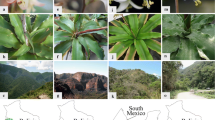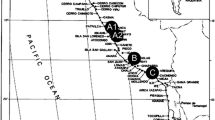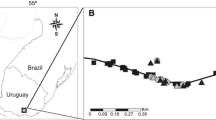Abstract.
Isozyme markers and morphological characters were studied in four populations of Sphagnum capillifolium and S. quinquefarium. Recombinant plants were found in three populations, where the two species occur sympatrically. All recombinants possessed different haplotypes and combinations of morphological characters, which show that they are results of independent hybridization events. Strongly male-biased sex ratios were found for Sphagnum capillifolium in all populations where it grew sympatrically with S. quinquefarium. Most of the recombinants were also male fertile. These observations suggest that S. quinquefarium is the female parent in the primary crosses and in subsequent backcrosses.
Similar content being viewed by others
Author information
Authors and Affiliations
Additional information
Received September 3, 2001; accepted March 16, 2002 Published online: November 7, 2002
Addresses of the authors: Nils Cronberg (e-mail: Nils.Cronberg@sysbot.lu.se), Department of Systematic Botany, Lund University, Sölvegatan 37, SE-223 62 Lund, Sweden. Rayna Natcheva (e-mail: renimoss@iph.bio.bas.bg), Institute of Botany, Bulgarian Academy of Sciences, 23 Acad. G. Bonchev Str., 1113 Sofia, Bulgaria.
Rights and permissions
About this article
Cite this article
Cronberg, N., Natcheva, R. Hybridization between the peat mosses, Sphagnum capillifolium and S. quinquefarium (Sphagnaceae, Bryophyta) as inferred by morphological characters and isozyme markers. Plant Syst. Evol. 234, 53–70 (2002). https://doi.org/10.1007/s00606-002-0196-y
Issue Date:
DOI: https://doi.org/10.1007/s00606-002-0196-y




